Working in hot conditions isn’t just difficult - it can be dangerous. When the human body is unable to maintain a normal temperature, heat-related illnesses can occur and may result in death. Be prepared and decrease the chances of your employees overheating by protecting them from heat-related illnesses.
Heat Awareness
The risk of heat-related illnesses and stress is increased in employees who work outdoors and in hot environments, such as bakeries, construction sites, factories, farms, fires, and mines. The risk is greater for workers who are over the age of 65, overweight, or have high blood pressure. Heat stroke is the most serious heat-related disorder and can occur when the body can no longer control its temperature and emergency treatment is not provided. Other common disorders include heat exhaustion, heat cramps, and heat rash.
Avoid heat-related illnesses by protecting your employees. Always provide them with water to stay hydrated and encourage them to avoid alcohol and caffeine. It’s important for them to pace themselves, take frequent breaks in the shade or air conditioning, and understand their personal limits and ability to work safely in the heat. If your employees are going to be outside, remind them to apply sunscreen and wear lightweight, loose-fitted clothing and a brimmed hat to protect themselves from the direct sun. If possible, schedule their shifts earlier or later in the day to avoid the extreme midday heat. A damp rag on their face and neck also helps to lower body temperature and cool them down.
Employers should proactively protect their employees in extreme heat by providing breaks in air conditioned or shaded areas with cooling stations supplied with plenty of water. These actions will help keep employees healthy, productive, and safe. They also limit any liability or lost work time due to heat-related illness.
Hydration
Hydration is always important, especially in hot and humid weather. The human body consists of 60% water, making excessive sweating and dehydration a threat to our health. When the temperature is hot, blood vessels dilate, increasing blood flow to the skin, allowing excess heat to radiate from your body in the form of sweat. The more time spent working or exercising outdoors, the more water is needed to replenish the fluids lost through excessive sweating. A good rule of thumb when working in the heat is to drink 1 cup of water every 15-20 minutes. Drinking at shorter intervals is more effective and hydrating than drinking large amounts infrequently. Encourage employees to take advantage of the provided shady water breaks which will boost productivity in the long run.
Protect your employees from overheating and developing a heat-related disorder by avoiding direct sun and midday heat, staying hydrated, taking breaks, and understanding their limits. If your employee experiences any signs of heat illness, Trinity’s Occupational Health and Urgent Care team stands ready to assist you.
